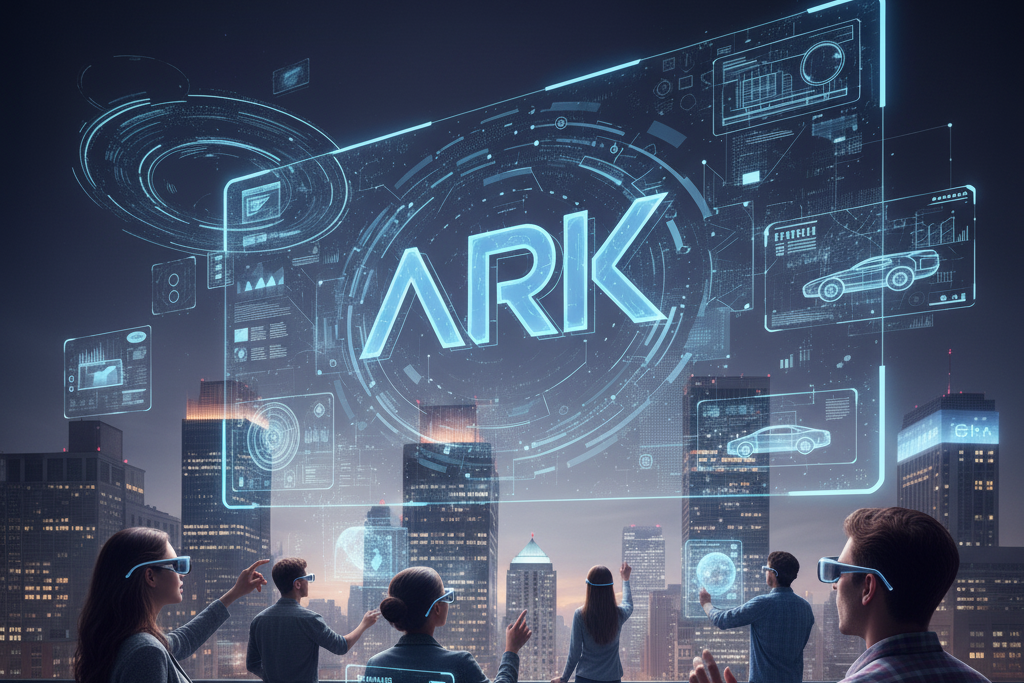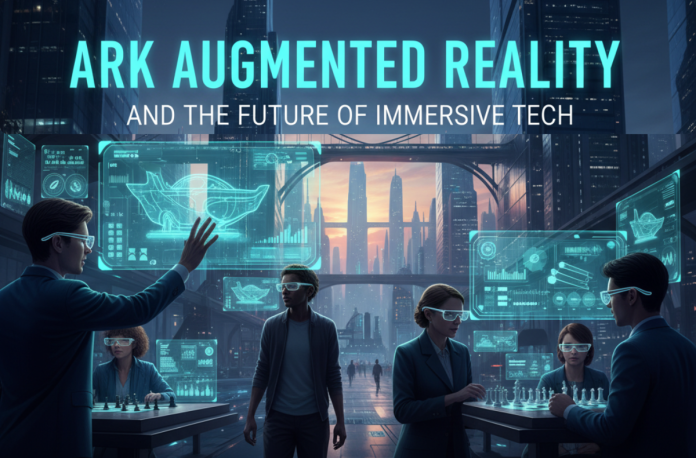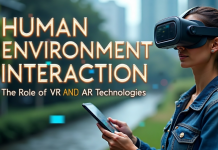Do you think it is possible to walk into a universe where digital and real worlds melt into one another, where we could touch virtual objects like they were actually there? Well, this is no longer science fiction. It’s the revolutionary promise of ARK augmented reality technology. The innovative ARK (Augmented Reality Kiosk) system, developed by researchers at the Computer Graphics Centre in Portugal, marks a milestone in immersive tech investment and illustrates that cutting-edge HMDs are not a necessity for creating wonderful experiences in augmented reality.
More than just another prototype in AR, the ARK system represents a proof-of-concept technology that could make it available to wider audiences at drastically reduced costs and complexity. Using creative engineering, ARK combines a standard 21-inch monitor with smart designs to tackle one of the main challenges in AR: the occlusion problem that occurs when real objects interfere with virtual displays.
Table of Contents
- Understanding the Basics of Ark Augmented Reality
- Market Size, Trends & Investment (U.S.)
- AR / VR / Mixed Reality
- Interactive Tech with Emergent Learning Ability
- Ark Augmented Reality Technical Limits and Ethics
- Ark Augmented Reality Market Growth and Trends
- The Future of Immersive Tech
- Next Steps for Ark Augmented Reality in the U.S.
- FAQs
Understanding the Basics of Ark Augmented Reality
Ark augmented reality goes beyond static overlays by blending knowledge, memory, adaptability, emergent behavior, and interactive scene generation. It can read its surroundings, adjust in real-time, and respond through visuals, sound, or feedback, making Ark augmented reality examples more personal and dynamic.
- Knowledge memory in AR: Using past interactions or external knowledge bases (e.g., via large language models, knowledge graphs). So that the system “remembers” styles, preferences, or environmental context.
- Interactive emergent ability: The ability to generate new, meaningful responses or content in situations not explicitly programmed, e.g., adapting virtual furniture layout to a room’s lighting and obstruction.
- Augmented reality scene generation: Building or editing 2D/3D scenes dynamically, even in unseen physical or virtual environments.
- App architecture: Ark augmented reality app designs often involve cross-modality input (voice, gesture, location) and real-time tracking.
The Technical Foundation
Although it may not be the most expensive component, ARK’s hardware shows that the most effective AR could operate on a modest configuration, namely:
| Component | Specification | Purpose |
|---|---|---|
| Display | 21-inch common monitor | Projects AR content |
| Mirror | Half-silvered mirror | Reflects virtual images into interaction space |
| Tracking | Ascension Flock of Birds with 2 position sensors | Tracks head and hand position |
| Interaction | CyberGlove with 22 sensors | Enables natural hand gesture control |
| Processing | SGI Octane workstation | Renders real-time AR content |
| Software | Virtual Design2 by VRCOM | VR modeling and interaction |
This relatively modest hardware setup performs something quite something. It creates an AR environment through which users can intuitively operate in real and virtual worlds with their hands while looking at the usual reflection on a monitor.
Market Size, Trends & Investment (U.S.)
Understanding where Ark augmented reality fits requires examining the larger immersive tech and AR/VR markets, particularly in the U.S.
- The U.S. immersive technology market, which includes AR, VR, and MR, was estimated at USD 11.2 billion in 2023. It is expected to grow at a rate of about 23.9% each year from 2024 to 2030.
- The global AR market was valued at about USD 93.67 billion in 2024. North America held the largest share. The U.S. AR market is expected to reach around USD 342.73 billion by 2032.
- Analysts anticipate strong interest in immersive technology investment, particularly among businesses that utilize AR/VR for training, retail, design, healthcare, and entertainment. Ark is well-positioned to thrive thanks to its advanced capabilities.
Thus, Ark augmented reality appears at a time when U.S. Investors, tech firms, startups, and public institutions are steadily pouring more money and research into immersive technology, fresh innovations, and next-generation content.

AR / VR / Mixed Reality
To explain how Ark connects with other immersive technology types, here’s a comparison:
| Technology | Key Strengths | Limitations Compared to the ARK augmented reality | Common Use Cases |
|---|---|---|---|
| Standard AR (non-Ark) | Still often hardware-bound, less scalable, and often expensive, content creation is more complex. | It has a limited understanding of knowledge, memory, scene generation, and emergent behavior. It might rely on markers or fixed models. | Retail try-on, social media AR filters, basic wayfinding. |
| Virtual Reality (VR) | Full immersion; controlled environments; strong for simulation, gaming. | No direct integration with real-world context. The hardware is bulky. There is less spontaneous adaptation. | Gaming, simulations, virtual tours. |
| Mixed Reality (MR) | Blend of virtual and real; can provide more natural integration; stronger hardware. | Still often hardware-bound, less scalable, and often expensive, content creation is more complex. | Still often hardware-bound; less scalable; often expensive; content creation is more complex. |
| Ark augmented reality | Limitations Compared to the Ark augmented reality | More computational/hardware demands; more data needed; privacy/ethical concerns; more complex UX design. | Next-gen urban planning, adaptive public art, education, immersive storytelling, etc. |
Interactive Tech with Emergent Learning Ability
The ArK Model (Huang et al., 2023)
The research ArK: Augmented Reality with Knowledge-Interactive Emergent Ability establishes a blueprint for how ARK augmented reality might work in practice. Key takeaways:
- It uses knowledge memory from foundation models and external sources to handle unseen scene understanding and scene generation/editing.
- It demonstrates how Ark augmented reality can improve the quality of generated 2D/3D scenes compared to baseline AR or VR models when faced with novel physical spaces.
- It underscores the importance of cross-modality (vision, text, and audio) and human-AI interaction in collecting contextual cues.
Practical Applications in the U.S.
Here are both existing and near-future ARK augmented reality examples, drawn from real U.S. contexts or possible applications:
- Wearable AR technology: Smart glasses or mixed reality headsets that enable ARK augmented reality, allowing users to see overlaid content that adapts to surroundings, e.g., historical overlays in heritage zones, or alerts in industrial settings.
- Architecture and urban planning: Local governments are using AR for public consultations. Ark could make it possible to dynamically generate shadow projections, adapt styles, and overlay community feedback for proposed buildings..
- Education: In the US, with the advent of Ark augmented reality, students can now learn through apps that adapt to their existing knowledge, respond to their surroundings, and progress at a pace that suits their learning style.
- Retail & marketing: Retail & marketing: brands use AR apps to help customers in retail and marketing. The apps suggest colors, placement, room shapes, and lighting.
- Entertainment & streaming: The integration of Ark with video streaming services. Imagine interactive video content where actors or objects appear in your room in mixed reality.
Ark Augmented Reality Technical Limits and Ethics
Making Ark augmented reality a reality comes with its own set of big challenges:
- Hardware and computational resources: Running Ark augmented reality in real time takes a lot. It requires powerful processors, reliable systems, and high-quality hardware to handle scene generation and create seamless, immersive experiences.
- Latency, tracking, and changes: These are major hurdles in the environment. The challenge is to ensure that virtual content blends seamlessly with real spaces, even when the lighting changes, new obstacles arise, or the surroundings are unpredictable.
- Content creation burden: The heavy lift of producing assets, models, text, and graphics tailored to different scenarios. Training systems to understand style and context.
- Privacy, security, and bias: Knowledge memory could involve storing user preferences and spatial data. People have concerns about who owns 3D scans of private spaces and the potential bias in the algorithms.

Comparing ARK to Contemporary AR Solutions
Comparing ARK with other AR systems that existed at that time, as well as some modern ones, is essential for understanding ARK in the spectrum of AR:
| AR Approach | Advantages | Disadvantages | Best Use Cases |
|---|---|---|---|
| Head-Mounted Displays (HoloLens, Magic Leap) | Fully immersive, mobile, wide field of view | Information kiosks, education, and demonstrations | Industrial training, remote assistance |
| ARK Monitor-Based System | Low cost, accessible, stable viewing | Single user, limited interaction space | Information kiosks, education, demonstrations |
| Projection-Based Systems | Large display area, multiple users | Complex setup, lighting sensitive | Museums, exhibitions, presentations |
| Mobile AR (ARKit, ARCore) | Widely accessible, portable | Limited interaction, small screen | Social media, shopping, navigation |
ARK occupies a unique niche that offers the stability and visual quality of stationary systems, combined with cost-effectiveness and ease of use, in a truly exceptional manner. It differs from the Virtual Showcase system that inspired it in that it incorporates interactivity in ARK, allowing users to manipulate objects instead of just viewing them.
Ark Augmented Reality Market Growth and Trends
Between 2023 and 2025, the U.S. immersive technology market was valued at approximately $11.2 billion and is expected to grow at a rate of nearly 24% per year through 2030. Ark augmented reality is poised to capture a larger share of this growth, particularly in the enterprise, education, and public sectors.
In North America, the AR-only market is as strong as the ARK. Both consumers and businesses will be more willing to invest in apps, hardware, and wearables. While a significant amount of money is already flowing into AR/VR stocks, devices, and software, Ark augmented reality stands out as a disruptive innovation, likely to attract new R&D and venture funding, particularly in the combination of AI and AR.
Standard AR scene generation still struggles in new environments, but Ark augmented reality, with its ability to generate and edit scenes in previously unseen spaces, shows real promise in overcoming these limits. And although wearable AR technology like smart glasses and headsets has seen slow adoption due to cost and comfort, improvements in devices and the rise of AR augmented reality apps could finally make wearables mainstream in both consumer and
The Future of Immersive Tech
Here are areas in the US where Ark Augmented Reality is likely to grow and shape the immersive tech landscape.
- Integration with streaming and video platforms: Ark and video streaming services will merge.
- Remote and Hybrid work: Ark augmented reality will create virtual meeting spaces that combine backgrounds, shared holograms, physical locations, and memories of collaborators. This tech will respond to the environment and user input.
- Health, accessibility, and training: Medical training, emergency response, therapy, and educational tools will benefit from Ark’s augmented reality capability to adjust visuals based on a user’s learning history or sensory needs.
- Consumer wearables and fashion: AR glasses, smart contact lenses, attire that embeds AR for fashion, display, or utility features; ARK augmented reality will require wearable hardware that supports knowledge memory, scene generation.
Next Steps for Ark Augmented Reality in the U.S.
To tap into the potential of Ark augmented reality, U.S. stakeholders, whether businesses, educators, or government, should take these steps:
- Deeply monitor immersive tech trends, especially around scene generation, knowledge memory, and emergent behavior.
- Study standards and policy frameworks for privacy, public safety, signage rules, and consent. This helps trust in ARK augmented reality and VR / virtual reality intersections.
- Prioritize wearable AR technology that’s affordable, ergonomic, and accessible.
- Also, analyze the pilot programs using ARK augmented reality in education, public planning, heritage preservation, and health to prove its value in real, everyday U.S. settings.
FAQs
Standard AR overlays images or graphics onto the real world, think filters, markers, or static models, without changing much based on context. On the other hand, the Ark augmented reality drawing on studies like ArK with Knowledge Interactive Emergent Ability, adds knowledge, memory, and interactive emergent ability, enabling dynamic scene generation in unseen environments and adapting content based on what it “learns” from the surroundings
Many of Ark’s augmented reality’s advanced features, such as scene generation in new places, knowledge memory, and emergent behavior, come from using foundation models and strong systems. But some U.S. AR apps already approximate parts of this: lighter versions of ARK are possible if developers focus on simpler rules, pre-encoded environment templates, or limited interactivity.
While full examples of Ark augmented reality aren’t widespread yet, there are strong precursors. However, the ARK with Knowledge Interactive Emergent Ability research demonstrates what app or system features to expect in the future.
Ark augmented reality shares more in common with AR and MR (mixed reality) than with VR (virtual reality). AR overlays digital content onto the real world, while MR goes further by letting those digital elements interact with physical surroundings.
Ark augmented reality involves knowledge memory, which means storing and recalling user data or context. It also includes scene scanning and possibly continuous observation of environments.











